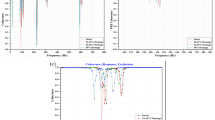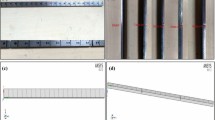Abstract
Damage identification of structures has attracted attention of researchers due to sudden collapse of in-service structures. Modal parameters and their derivatives have been widely employed in the proposed damage identification techniques. However, mode shape differences have been shown to be an ideal damage indicator when used as the input vector of neural networks. Since measurement of higher-order mode shapes is very difficult to be acquired reliably, this study investigated the adequacy of using only the first mode shape differences for damage identification using artificial neural networks. Results of numerical and experimental studies on a cantilever beam indicated that the first mode shape differences alone can accurately localize imposed damages. Damage intensity at the lower levels of cantilever beam was predicted with less than 15% error; however, prediction of damage intensity at the free end of the beam encountered large discrepancies. It was also found that damage localization was successful even when the first mode shape differences were measured at few points along the beam.












Similar content being viewed by others
References
Vafaei M, Adnan AB, Rahman AB Abd (2014) A neuro-wavelet technique for seismic damage identification of cantilever structures. Struct Infrastruct Eng 10(12):1666–1684
Fan W, Qiao P (2011) Vibration-based damage identification methods: a review and comparative study. Struct Health Monit 10(1):83–111
Vafaei M, Adnan AB (2014) Seismic damage detection of tall airport traffic control towers using wavelet analysis. Struct Infrastruct Eng 10(1):106–127
Zhan JW, Xia H, Chen SY, De Roeck G (2011) Structural damage identification for railway bridges based on train-induced bridge responses and sensitivity analysis. J Sound Vib 330(4):757–770
Arangio S, Bontempi F (2015) Structural health monitoring of a cable-stayed bridge with Bayesian neural networks. Struct Infrastruct Eng 11(4):575–587
Vafaei M, Adnan AB, Rahman AB Abd (2013) Real-time seismic damage detection of concrete shear walls using artificial neural networks. J Earthq Eng 17(1):137–154
Vafaei M, Alih SC, Rahman ABA, Adnan AB (2015) A wavelet-based technique for damage quantification via mode shape decomposition. Struct Infrastruct Eng 11(7):869–883
Bandara RP, Chan TH, Thambiratnam DP (2014) Frequency response function based damage identification using principal component analysis and pattern recognition technique. Eng Struct 66:116–128
Wu X, Ghaboussi J, Garrett JH (1992) Use of neural networks in detection of structural damage. Comput Struct 42(4):649–659
Sahin M, Shenoi RA (2003) Quantification and localization of damage in beam-like structures by using artificial neural networks with experimental validation. Eng Struct 25(14):1785–1802
Li J, Dackermann U, Xu Y, Samali B (2011) Damage identification in civil engineering structures utilizing PCA-compressed residual frequency response functions and neural network ensembles. Struct Control Health Monit 18(2):207–226
Yam LH, Yan YJ, Jiang JS (2003) Vibration-based damage detection for composite structures using wavelet transform and neural network identification. Compos Struct 60(4):403–412
Lee JJ, Lee JW, Yi JH, Yun CB, Jung YJ (2005) Neural network based damage detection for bridges considering errors in baseline finite elements models. J Sound Vib 280(3):555–578
Mehrjoo M, Khaji N, Moharrami H, Bahreininejad A (2008) Damage detection of truss bridge joints using artificial neural networks. Expert Syst Appl 35(3):1122–1131
Zang C, Imregun M (2001) Structural damage detection using artificial neural networks and measured FRF data reduced via principal component projection. J Sound Vib 242(5):813–827
Qi GZ, Xun G, Xiaozhai Q, Dong W, Chang P (2005) Local measurement for structural health monitoring. Earthq Eng Eng Vib 4(1):165–172
Wilson EL, Habibullah A (2003) Structural Analysis Program Sap 2000. Berkeley, Calif. Computer and Structures Inc, Users Manual
Dackermann U (2010) Vibration-based damage identification methods for civil engineering structures using artificial neural networks. Ph.D. Thesis, University of Technology Sydney. Sydney, Australia
Lyn Dee G, Bakhary N, Abdul Rahman A, Hisham Ahmad B (2011) A comparison of artificial neural network learning algorithms for vibration-based damage detection. Adv Mater Res 163:2756–2760
Acknowledgement
Authors are thankful to the comments from anonymous reviewers. In addition, the financial support from Malaysian Ministry of Higher Education under the Grant No. R.J130000.7822.4F760 is greatly acknowledged.
Author information
Authors and Affiliations
Corresponding author
Ethics declarations
Conflict of interest
The authors declare that they have no conflict of interest.
Rights and permissions
About this article
Cite this article
Vafaei, M., Alih, S.C. Adequacy of first mode shape differences for damage identification of cantilever structures using neural networks. Neural Comput & Applic 30, 2509–2518 (2018). https://doi.org/10.1007/s00521-017-2846-6
Received:
Accepted:
Published:
Issue Date:
DOI: https://doi.org/10.1007/s00521-017-2846-6




